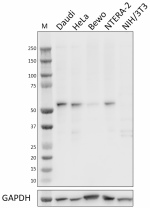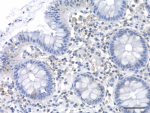- Clone
- KH20 (See other available formats)
- Regulatory Status
- RUO
- Other Names
- PBR3, E2F Transcription Factor 1, Retinoblastoma-associated protein 1, Retinoblastoma-binding protein 3, RBAP-1, RBBP-3, PRB-Binding Protein E2F-1, Transcription Factor E2F1
- Isotype
- Mouse IgG2a, κ
- Ave. Rating
- Submit a Review
- Product Citations
- publications

-

Whole cell extracts (15 µg total protein) from Daudi, HeLa, BeWo, NTERA-2, and NIH/3T3 cells were resolved by 4-12% Bis-Tris gel electrophoresis, transferred to a PVDF membrane, and probed with 1.0 μg/mL of purified anti-E2F1 (clone KH20) overnight at 4°C. Proteins were visualized by chemiluminescence detection using HRP goat anti-mouse IgG (Cat. No. 405306) at a 1:3000 dilution. Direct-Blot™ HRP anti-GAPDH (Cat. No. 607904) was used as a loading control at a 1:25000 dilution (lower). Lane M: Molecular weight marker -

HeLa cells were fixed with 4% paraformaldehyde for 10 minutes, permeabilized with MEOH for 10 minutes, and blocked with 5% FBS for 60 minutes. Cells were then intracellularly stained with 5.0 µg/mL (1:100 dilution) of either purified mouse IgG2a, κ isotype control (Cat. No. 401501) (panel A) or purified anti-E2F1 (clone KH20) (panel B) overnight at 4°C, followed by incubation with Alexa Fluor® 594 goat anti-mouse IgG (Cat. No. 405326) at 2.0 µg/mL. Nuclei were counterstained with DAPI and the image was captured with a 60X objective. Scale: 50 µm -

IHC staining of purified anti-E2F1 (clone KH20) on formalin-fixed paraffin-embedded human colon tissue. Following antigen retrieval using Sodium Citrate H.I.E.R. (Cat. No. 928502), the tissue was incubated with 10.0 µg/mL of the primary antibody overnight at 4°C. BioLegend’s Ultra Streptavidin HRP Kit (Multi-Species, DAB) (Cat. No. 929501) was used for detection followed by hematoxylin counterstaining, according to the protocol provided. The image was captured with a 40X objective. Scale bar: 50 μm
| Cat # | Size | Price | Quantity Check Availability | Save | ||
|---|---|---|---|---|---|---|
| 606051 | 25 µg | 95€ | ||||
| 606052 | 100 µg | 278€ | ||||
E2F1 is a member of the E2F family of transcription factors, which is comprised of 6 members that display both activator and repressor functions. The primary functions of E2F1 are transcription activation and cell cycle regulation, namely in replication, DNA-damage response and repair, and apoptosis. E2F1 activation during G1 phase of cell cycle is vital for the transition into S phase and the subsequent replication and synthesis of DNA. Beyond its role in cell cycle control, E2F1 is a regulator of metabolism, primarily through β cell proliferation, insulin secretion, endocrine function, and adipogenesis. E2F1 activity is regulated through its binding to phosphorylated retinoblastoma protein (pRB) and through acetylation when in its pRB-free form.
E2F1 represents a critical target in cancer therapy. Through its stimulation of mTORC1 activity and tumor malignancy and growth, as well as its contribution to the Warburg effect by inducing glycolytic genes, E2F1 often behaves as an oncogene. Additionally, E2F1 can function as a tumor suppressor. Tumor-suppressive properties stem from its role in apoptosis through association with p53 and p73, as well as through inhibition of the NF-κB signaling pathway.
Product Details
- Verified Reactivity
- Human
- Antibody Type
- Monoclonal
- Host Species
- Mouse
- Immunogen
- GST fusion protein corresponding to full-length human E2F1. The epitope recognized by KH20 has been mapped to amino acids 1-89.
- Formulation
- Phosphate-buffered solution, pH 7.2, containing 0.09% sodium azide
- Preparation
- The antibody was purified by affinity chromatography.
- Concentration
- 0.5 mg/mL
- Storage & Handling
- The antibody solution should be stored undiluted between 2°C and 8°C.
- Application
-
WB- Quality tested
ICC, IHC-P - Verified - Recommended Usage
-
Each lot of this antibody is quality control tested by western blotting. For western blotting, the suggested use of this reagent is 0.5 - 1.0 µg/mL. For immunocytochemistry, a concentration range of 2.5 - 5.0 μg/mL is recommended. For immunohistochemistry on formalin-fixed paraffin-embedded tissue sections, a concentration range of 10.0 - 20.0 µg/mL is suggested. It is recommended that the reagent be titrated for optimal performance for each application.
- Application Notes
-
This product does not cross-react with mouse by WB.
This antibody works by ICC using a variety of fixation permeabilization methods such as: fixation with either methanol or 4% PFA followed by permeabilization with either 0.5% Triton-X or 100% ice-cold methanol. - RRID
-
AB_2924616 (BioLegend Cat. No. 606051)
AB_2924616 (BioLegend Cat. No. 606052)
Antigen Details
- Structure
- E2F1 is a 437 amino-acid protein with a predicted molecular weight of 46.9 kD
- Distribution
-
Ubiquitously expressed/Nucleus
- Function
- Transcription factor/cell cycle
- Interaction
- E2F1 forms heterodimers with proteins of the Dimerization Partner (DP family).
- Biology Area
- Apoptosis/Tumor Suppressors/Cell Death, Cell Cycle/DNA Replication, Transcription Factors
- Antigen References
-
- Denechaud P, et al. 2017. Front. Endocrinol. 8:311.
- Liang Y, et al. 2015. Int. J. Oncol. 48:1650.
- Martinez-Balbas M, et al. 2000. Embo J. 19:662.
- Wu Z, et al. 2009. Int. J. Biochem. Cell Biol. 41:2389.
- Gene ID
- 1869 View all products for this Gene ID
- UniProt
- View information about E2F1 on UniProt.org
Related Pages & Pathways
Pages
Related FAQs
Other Formats
View All E2F1 Reagents Request Custom Conjugation| Description | Clone | Applications |
|---|---|---|
| Purified anti-E2F1 | KH20 | WB,ICC,IHC-P |
Compare Data Across All Formats
This data display is provided for general comparisons between formats.
Your actual data may vary due to variations in samples, target cells, instruments and their settings, staining conditions, and other factors.
If you need assistance with selecting the best format contact our expert technical support team.
 Login / Register
Login / Register 










Follow Us